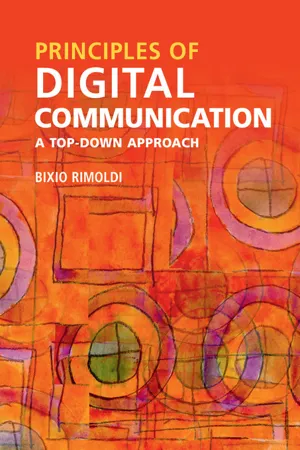
- English
- PDF
- Available on iOS & Android
About this book
This comprehensive and accessible text teaches the fundamentals of digital communication via a top-down-reversed approach, specifically formulated for a one-semester course. The unique approach focuses on the transmission problem and develops knowledge of receivers before transmitters. In doing so it cuts straight to the heart of the digital communication problem, enabling students to learn quickly, intuitively, and with minimal background knowledge. Beginning with the decision problem faced by a decoder and going on to cover receiver designs for different channels, hardware constraints, design trade-offs, convolutional coding, Viterbi decoding, and passband communication, detail is given on system-level design as well as practical applications in engineering. All of this is supported by numerous worked examples, homework problems, and MATLAB simulation exercises to aid self-study, providing a solid basis for students to specialize in the field of digital communication and making it suitable for both traditional and flipped classroom teaching.
Frequently asked questions
- Essential is ideal for learners and professionals who enjoy exploring a wide range of subjects. Access the Essential Library with 800,000+ trusted titles and best-sellers across business, personal growth, and the humanities. Includes unlimited reading time and Standard Read Aloud voice.
- Complete: Perfect for advanced learners and researchers needing full, unrestricted access. Unlock 1.4M+ books across hundreds of subjects, including academic and specialized titles. The Complete Plan also includes advanced features like Premium Read Aloud and Research Assistant.
Please note we cannot support devices running on iOS 13 and Android 7 or earlier. Learn more about using the app.
Information
Table of contents
- Cover
- Half-title
- Endorsements
- Title page
- Copyright information
- Dedication
- Table of contents
- Preface
- Acknowledgments
- List of symbols
- List of abbreviations
- 1 Introduction and objectives
- 2 Receiver design for discrete-time observations: First layer
- 3 Receiver design for the continuous-time AWGN channel:Second layer
- 4 Signal design trade-offs
- 5 Symbol-by-symbol on a pulse train: Second layer revisited
- 6 Convolutional coding and Viterbi decoding: First layer revisited
- 7 Passband communication via up/down conversion: Third layer
- Bibliography
- Index